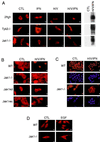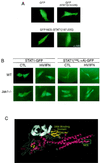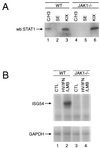Regulation of STAT1 nuclear export by Jak1
- PMID: 10982844
- PMCID: PMC86281
- DOI: 10.1128/MCB.20.19.7273-7281.2000
Regulation of STAT1 nuclear export by Jak1
Abstract
Signal transducer and activator of transcription 1 (STAT1) mediates gene expression in response to cytokines and growth factors. Activation of STAT1 is achieved through its tyrosine phosphorylation, a process that involves Jak tyrosine kinases. Here we show that STAT1, although phosphorylated on Y701, is unable to localize in the nucleus in the absence of Jak1 or Jak1 kinase activity. In contrast, the nuclear accumulation of STAT1 in Tyk2-deficient cells remains intact. Nuclear presence of tyrosine-phosphorylated STAT1 could be restored in Jak1-deficient cells by leptomycin B, an inhibitor of nuclear export. Amino acids 197 to 205 of STAT1 were found to encode a leucine-rich nuclear export signal (NES). An L-->A mutation within the NES restored nuclear retention of STAT1 in Jak1-deficient cells. Impaired binding of the transcriptional coactivator CBP to tyrosine-phosphorylated STAT1 derived from Jak1-deficient cells offers a model for the intermolecular regulation of the nuclear export sequence.
Figures





Similar articles
-
Urokinase activates the Jak/Stat signal transduction pathway in human vascular endothelial cells.Arterioscler Thromb Vasc Biol. 1999 Feb;19(2):290-7. doi: 10.1161/01.atv.19.2.290. Arterioscler Thromb Vasc Biol. 1999. PMID: 9974409
-
Nucleocytoplasmic translocation of Stat1 is regulated by a leucine-rich export signal in the coiled-coil domain.Proc Natl Acad Sci U S A. 2000 Sep 12;97(19):10418-23. doi: 10.1073/pnas.190318397. Proc Natl Acad Sci U S A. 2000. PMID: 10973496 Free PMC article.
-
Constitutive STAT1 tyrosine phosphorylation in U937 monocytes overexpressing the TYK2 protein tyrosine kinase does not induce gene transcription.Cell Growth Differ. 1996 Jun;7(6):833-40. Cell Growth Differ. 1996. PMID: 8780896
-
Stats: transcriptional control and biological impact.Nat Rev Mol Cell Biol. 2002 Sep;3(9):651-62. doi: 10.1038/nrm909. Nat Rev Mol Cell Biol. 2002. PMID: 12209125 Review.
-
Regulation of the Jak/STAT signalling pathway.Cell Signal. 1995 Nov;7(8):739-45. doi: 10.1016/0898-6568(95)02004-7. Cell Signal. 1995. PMID: 8593242 Review. No abstract available.
Cited by
-
Principles of interleukin (IL)-6-type cytokine signalling and its regulation.Biochem J. 2003 Aug 15;374(Pt 1):1-20. doi: 10.1042/BJ20030407. Biochem J. 2003. PMID: 12773095 Free PMC article. Review.
-
STAT dynamics.Cytokine Growth Factor Rev. 2007 Oct-Dec;18(5-6):511-8. doi: 10.1016/j.cytogfr.2007.06.021. Epub 2007 Aug 1. Cytokine Growth Factor Rev. 2007. PMID: 17683973 Free PMC article. Review.
-
Pseudorabies Virus Inhibits Type I and Type III Interferon-Induced Signaling via Proteasomal Degradation of Janus Kinases.J Virol. 2021 Sep 27;95(20):e0079321. doi: 10.1128/JVI.00793-21. Epub 2021 Aug 11. J Virol. 2021. PMID: 34379505 Free PMC article.
-
Selective STAT protein degradation induced by paramyxoviruses requires both STAT1 and STAT2 but is independent of alpha/beta interferon signal transduction.J Virol. 2002 May;76(9):4190-8. doi: 10.1128/jvi.76.9.4190-4198.2002. J Virol. 2002. PMID: 11932384 Free PMC article.
-
Novel drug targets for personalized precision medicine in relapsed/refractory diffuse large B-cell lymphoma: a comprehensive review.Mol Cancer. 2015 Dec 11;14:207. doi: 10.1186/s12943-015-0474-2. Mol Cancer. 2015. PMID: 26654227 Free PMC article. Review.
References
-
- Abola E E, Sussman J L, Prilusky J, Manning N O. Protein data bank archives of three-dimensional macromolecular structures. Methods Enzymol. 1997;277:556–571. - PubMed
-
- Ali S, Ali S. Prolactin receptor regulates Stat5 tyrosine phosphorylation and nuclear translocation by two separate pathways. J Biol Chem. 1998;273:7709–7716. - PubMed
-
- Arenzana-Seisdedos F, Turpin P R, Thomas M D, Hay R T, Virelizier J L, Dargemont C. Nuclear localization of I kappa B alpha promotes active transport of NF-kappa B from the nucleus to the cytoplasm. J Cell Sci. 1997;110:369–378. - PubMed
-
- Chen X, Vinkemeier U, Zhao Y, Jeruzalmi D, Darnell J E, Kuriyan J. Crystal structure of a tyrosine phosphorylated STAT-1 dimer bound to DNA. Cell. 1998;93:827–839. - PubMed
-
- Darnell J E, Kerr I M, Stark G R. Jak-STAT pathways and transcriptional activation in response to IFNs and other extracellular signaling proteins. Science. 1994;264:1415–1421. - PubMed
Publication types
MeSH terms
Substances
Grants and funding
LinkOut - more resources
Full Text Sources
Molecular Biology Databases
Research Materials
Miscellaneous
